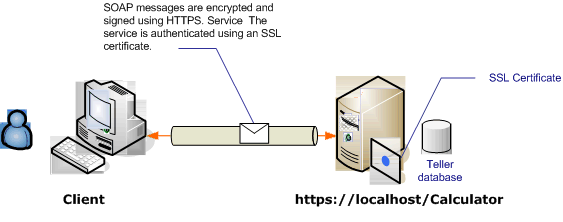Seguridad de transporte con un cliente anónimo
Este escenario de Windows Communication Foundation (WCF) usa la seguridad de transporte (HTTPS) para garantizar la confidencialidad y la integridad. El servidor debe autenticarse con un certificado de Capa de sockets seguros (SSL) y los clientes deben confiar en el certificado del servidor. Ningún mecanismo autentica el cliente y es, por lo tanto, anónimo.
Para obtener una aplicación de ejemplo, vea Seguridad de transporte de WS. Para obtener más información sobre la seguridad de transporte, vea Información general sobre seguridad de transporte.
Para obtener más información sobre el uso de un certificado con un servicio, vea Uso de certificados y Procedimientos para configurar un puerto con un certificado SSL.

| Característica | Descripción |
|---|---|
| Modo de seguridad | Transporte |
| Interoperabilidad | Con servicios y clientes Web existentes |
| Autenticación (servidor) Autenticación (cliente) |
Sí Nivel de aplicación (sin compatibilidad con WCF) |
| Integridad | Sí |
| Confidencialidad | Sí |
| Transporte | HTTPS |
| Enlace | WSHttpBinding |
Servicio
El código y la configuración siguientes están diseñados para ejecutarse de forma independiente. Realice una de las siguientes acciones:
Cree un servicio independiente mediante el código sin configuración.
Cree un servicio mediante la configuración proporcionada, pero sin definir ningún punto de conexión.
Código
El código siguiente muestra cómo crear un extremo mediante la seguridad del transporte:
// Create the binding.
WSHttpBinding binding = new WSHttpBinding();
binding.Security.Mode = SecurityMode.Transport;
binding.Security.Transport.ClientCredentialType =
HttpClientCredentialType.None;
// Create the URI for the endpoint.
Uri httpUri = new Uri("https://localhost/Calculator");
// Create the service host and add an endpoint.
ServiceHost myServiceHost =
new ServiceHost(typeof(ServiceModel.Calculator), httpUri);
myServiceHost.AddServiceEndpoint(
typeof(ServiceModel.ICalculator), binding, "");
// Open the service host.
myServiceHost.Open();
Console.WriteLine("Press Enter to exit....");
Console.ReadLine();
// Close the service.
myServiceHost.Close();
' Create the binding.
Dim binding As New WSHttpBinding()
binding.Security.Mode = SecurityMode.Transport
binding.Security.Transport.ClientCredentialType = HttpClientCredentialType.None
' Create the URI for the endpoint.
Dim httpUri As New Uri("https://localhost/Calculator")
' Create the service host and add an endpoint.
Dim myServiceHost As New ServiceHost(GetType(ServiceModel.Calculator), httpUri)
myServiceHost.AddServiceEndpoint(GetType(ServiceModel.ICalculator), binding, "")
' Open the service host.
myServiceHost.Open()
Console.WriteLine("Press Enter to exit....")
Console.ReadLine()
' Close the service.
myServiceHost.Close()
Configuración
El código siguiente configura el mismo extremo mediante la configuración. Ningún mecanismo autentica el cliente y es, por lo tanto, anónimo.
<?xml version="1.0" encoding="utf-8"?>
<configuration>
<system.serviceModel>
<services>
<service name="ServiceModel.Calculator">
<endpoint address="https://localhost/Calculator"
binding="wsHttpBinding"
bindingConfiguration="WSHttpBinding_ICalculator"
name="SecuredByTransportEndpoint"
contract="ServiceModel.ICalculator" />
</service>
</services>
<bindings>
<wsHttpBinding>
<binding name="WSHttpBinding_ICalculator">
<security mode="Transport">
<transport clientCredentialType="None" />
</security>
</binding>
</wsHttpBinding>
</bindings>
<client />
</system.serviceModel>
</configuration>
Remoto
El código y la configuración siguientes están diseñados para ejecutarse de forma independiente. Realice una de las siguientes acciones:
Cree un cliente independiente mediante el código (y el código de cliente).
Cree un cliente que no defina direcciones de punto de conexión. En su lugar, utilice el constructor de cliente que adopta el nombre de configuración como un argumento. Por ejemplo:
CalculatorClient cc = new CalculatorClient("EndpointConfigurationName");Dim cc As New CalculatorClient("EndpointConfigurationName")
Código
// Create the binding.
WSHttpBinding myBinding = new WSHttpBinding();
myBinding.Security.Mode = SecurityMode.Transport;
myBinding.Security.Transport.ClientCredentialType =
HttpClientCredentialType.None;
// Create the endpoint address. Note that the machine name
// must match the subject or DNS field of the X.509 certificate
// used to authenticate the service.
EndpointAddress ea = new
EndpointAddress("https://machineName/Calculator");
// Create the client. The code for the calculator
// client is not shown here. See the sample applications
// for examples of the calculator code.
CalculatorClient cc =
new CalculatorClient(myBinding, ea);
// Begin using the client.
try
{
cc.Open();
Console.WriteLine(cc.Add(100, 1111));
// Close the client.
cc.Close();
}
' Create the binding.
Dim myBinding As New WSHttpBinding()
myBinding.Security.Mode = SecurityMode.Transport
myBinding.Security.Transport.ClientCredentialType = HttpClientCredentialType.None
' Create the endpoint address. Note that the machine name
' must match the subject or DNS field of the X.509 certificate
' used to authenticate the service.
Dim ea As New EndpointAddress("https://machineName/Calculator")
' Create the client. The code for the calculator
' client is not shown here. See the sample applications
' for examples of the calculator code.
Dim cc As New CalculatorClient(myBinding, ea)
' Begin using the client.
Try
cc.Open()
Console.WriteLine(cc.Add(100, 11))
Console.ReadLine()
' Close the client.
cc.Close()
Catch tex As TimeoutException
Console.WriteLine(tex.Message)
cc.Abort()
Catch cex As CommunicationException
Console.WriteLine(cex.Message)
cc.Abort()
Finally
Console.WriteLine("Closed the client")
Console.ReadLine()
End Try
Configuración
Se puede usar la configuración siguiente en lugar del código para configurar el servicio.
<configuration>
<system.serviceModel>
<bindings>
<wsHttpBinding>
<binding name="WSHttpBinding_ICalculator" >
<security mode="Transport">
<transport clientCredentialType="None" />
</security>
</binding>
</wsHttpBinding>
</bindings>
<client>
<endpoint address="https://machineName/Calculator"
binding="wsHttpBinding"
bindingConfiguration="WSHttpBinding_ICalculator"
contract="ICalculator"
name="WSHttpBinding_ICalculator" />
</client>
</system.serviceModel>
</configuration>